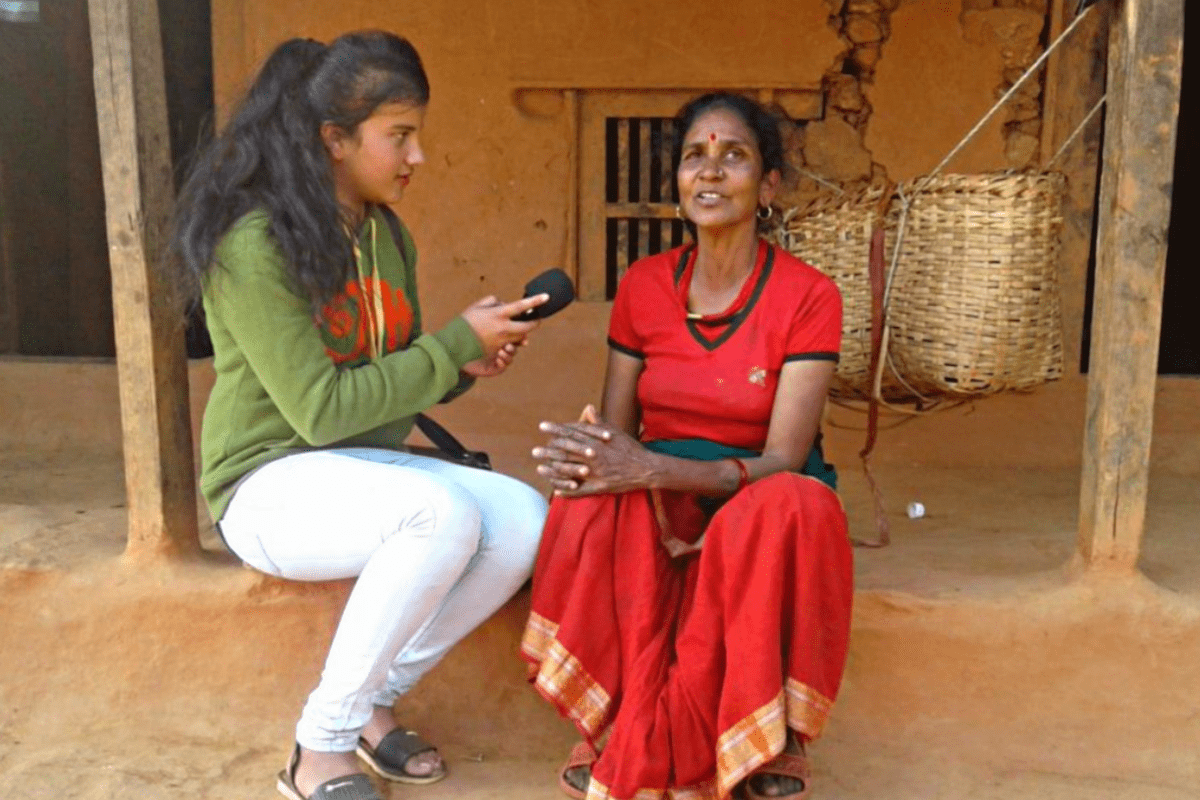
Using citizen feedback to solve local challenges
Written by Sanjeeta Pant
Maya Lama, a woman from Mangaltar village in Nepal, was one of the survivors of the 2015 earthquake which completely destroyed her house. The government- with donor support- set up a process for citizens to receive funds for reconstruction, but Maya was unable to receive these funds as she was not registered on the list of earthquake victims. Her husband was working abroad, and the property she lost was not in her name. But, thanks to the power of local advocacy and democracy, she joined a town hall meeting at which she spoke directly to the Secretary of the Village Development Committee – the local decision-making body in the region. The Secretary committed to address her concerns, and with support from local volunteers who helped her gather and complete all the relevant documents, she received the funding needed to rebuild her house.
Maya’s experience is one of hundreds of similar stories following the devastating earthquake. Accountability Lab’s Civic Action Teams (CivActs- formerly known as the Mobile Citizen Helpdesks) saw these needs and mobilized volunteers to bridge the information gap and respond to the unfolding humanitarian crisis. Since then the project has evolved to focus on solving a multiplicity of accountability challenges facing migrant workers and their families, like those with which Maya had to deal. After the earthquake, migration spiked- and we are now moving into a new phase of this project that aims to build accountability into local decision making in real-time more broadly; and to close the feedback loop between citizens, governments, the media and the private sector. As part of this process, we are reflecting on what we have learned and how the Lab’s values of collaboration and innovation led to a program that has grown and been replicated around the world.
This is the first in a series of reflective blogs that will look at how the agile nature of CivActs has facilitated a network of local stakeholders to respond to varying community needs – from earthquake response and migration to women’s rights. Later in the series we will look at what we have learned over the years in the other varied contexts in which we have deployed the CivActs model. Finally we will share how the model has catalyzed our ability to develop and undertake new programs that further aim to support the ability of communities to hold duty bearers to account.
From filling the information gap to closing the feedback loop
On 25 April 2015, Nepal made international headlines when a 7.8 magnitude earthquake struck close to Kathmandu. Almost 9,000 people lost their lives and more than 20,000 were injured. As the geological aftershocks fizzled, the economic and social aftershocks became apparent. From rampant corruption and mismanagement of public resources to a lack of basic service delivery, the earthquake exposed the numerous accountability challenges facing Nepal. The earthquake provided a window of opportunity for local civil society organizations, like Accountability Lab Nepal, to creatively address these challenges by developing mechanisms to hold those in power to account.
We mobilized our Civic Action Teams the day of the first earthquake, and the mechanism became a central citizen voice mechanism for the immediate response. In the subsequent weeks and months, we liaised with our networks – mostly volunteers from our Integrity Icon program who lived in some of the most rural parts of the country – to collect information, debunk rumors and close the loop on critical humanitarian concerns. Via text message we were alerted to the significant discrepancies between the resources and relief materials provided to those in urban versus rural areas. Many of the earthquake affected communities, especially those in rural areas, were unable to access relief materials not only due to lack of information, but also due to corruption and mismanagement. We realized that aside from ensuring that communities were able to access relief, there was also a real need for an effective mechanism to share information about other resources and services that were available to earthquake affected communities as well as to increase government accountability for where these services were being provided.
AL Nepal recruited 84 local journalists as Community Frontline Associates (CFAs) in 14 of the hardest hit districts. These journalists were instrumental in developing the community feedback model, which initially started out as an effort to connect affected communities with donors and local governments, understand their needs, and close the information gap around earthquake relief efforts. In the first eight months, CFAs held 64 community meetings, 13 of which were with women’s groups and 4 with other marginalized populations. During that time we reached 3,451 people directly through community meetings and over 100,000 through community radio. The meetings were critical to solving the problems faced by earthquake victims like Chandramaya and her husband, whose home reconstruction stalled because they didn’t have access to an engineer. Their challenge was broadcast by our radio journalists and shortly thereafter an engineer came forward to assist and Chandramaya was able to rebuild her house. In Kavrepalanchowk district, pregnant women were unable to access pre-natal care because the healthcare centers ran out of iron supplements. Our local CFA identified this need and communicated it to the District Health Office [DHO] who then prioritized the delivery of the supplements along with other nutrition. Through efforts like this, the CivActs became a central part of the post-earthquake response.
We soon realized that just being a conduit for information was not enough. As CFAs engaged with individual community members as well as specific groups (such as migrant workers, women and girls) to understand their individual problems, they began to lobby on behalf of earthquake victims and support them directly to access relief packages. Sunita Ban, a single woman from Sindhupalchowk, for instance, was unable to access government relief funds because she did not have a citizenship card. A CFA advocated on her behalf with the Chief District Officer to secure her citizenship card, which gave her access to government relief.
The stories, information and data collected through these engagements were shared back with the community through bulletins, infographics (in multiple local languages), and radio programs. Issues brought up during conversations with individuals or particular groups were also discussed in community or town hall meetings with other relevant stakeholders, including local government representatives. These meetings provided an open space for dialogue, follow up, problem solving and at a larger level, the renewal of trust. Kabiraj, a local man from Dhading district for example, had been waiting without a home for nearly two years. He had finished rebuilding his house’s foundation and was waiting for an engineer to inspect it so he could qualify for a government grant. After months of waiting, Kabiraj’s issue was addressed directly by an engineer from the National Reconstruction Authority (NRA), who he met at a community meeting with our CFAs. Similarly, five other households in Sindhupalchowk secured an inspection from the NRA engineers we brought to a community meeting with them, and were finally able to continue construction on their new homes. But as communities were celebrating the strides made in rebuilding infrastructure, a separate crisis was brewing in the aftermath of the earthquake.
Connecting the dots and identifying cross-cutting issues
Nepal’s economy is heavily reliant on remittances. As the economic crisis from the earthquake deepened so too did the economic burden which slowly gave rise to forced migration, including among women. Each year thousands of migrant workers, who are mostly from marginalized communities, leave Nepal in search of better economic opportunities. The Open Migration Perception Surveys carried out by the Lab around migration accountability in 2017 and 2018 in four of the most earthquake-affected districts of Nepal revealed that labor migrants were one of the most vulnerable groups in society. A few years prior to this in 2015, more than half a million Nepali migrants were already working in over 100 different countries. The vast majority of those migrant workers – at least 95 percent – were men, leaving many women-led rural post-earthquake households. Nepal is a patriarchal society with social and cultural norms often preventing women’s engagement in public affairs. This meant women had limited information or agency, including lack of ownership in properties damaged during the earthquake, and were unable to access government support and services. While CFAs helped these women to understand the processes and to gather paperwork required to access government relief, they also became aware of the structural and legal challenges facing migrant families. The economic focus of migration has meant people rarely see migration from a human rights or gender perspective. The accountability aspect is even less apparent even to migrant workers, who are often victims of fraud and trafficking.
It bears remembering that at the time of the earthquake, Nepal was balancing a number of challenges on the political, social and economic fronts- the Second Constitution Assembly was deliberating a new constitution for a federal Nepal; local elections had not been held since 1997; and the economy relied heavily on remittances, making up almost 30% of the country’s total GDP. In the absence of local government representatives, community issues- including around migration- were discussed at the central level and decisions were made outside local contexts. Communities that were dealing with the plight of young people leaving the country in hoards were not consulted. The CFAs found that the same information gathering and feedback model developed to help victims of the earthquake could be quickly adapted to address issues facing migrant workers and their families.
Adapting to context and replicating across borders
The 2017 local elections provided a new opportunity to test the CivActs approach. It was now possible to work with ward units, and government units closest to the community, to identify local issues and collaborate on solving them. For example, Jwalamukhi Rural Municipality in Dhading started working with CFAs to support migrant workers. The municipality later formed a committee with ward chairs to specifically address migration issues. While local representatives were skeptical at the beginning, they now have strong relationships with the CFAs and are collaborating across 85 local units to support returnee migrant workers through budget allocations, data collection and the creation of employment opportunities. Panauti Municipality, for instance, has also worked with CFAs to collect data on the needs of migrant workers and allocated a budget of NRP 6.5m ($50,000) to support returnee migrant workers to find livelihood options in agriculture and animal husbandry. Since 2019, six municipalities have allocated a total of NPR10.5m ($880,000m) to work on migration in part as a result of our efforts. Besides Paunauti, Jwalamukhi Rural Municipality has formed a committee with ward chairs to specifically address migration issues and allocated a budget of NPR 2.4m ($20,000m)
Local governments have also adapted this model to develop inclusive gender policies in Dhangadi; work on issues of fiscal transparency in Nepalgunj; and held public private partnership dialogues in Biratnagar and Butwal. Going forward there are a number of new opportunities that have arisen in Nepal which could use the CivActs Model- including elections, engagement of the private sector in key problems and with regard to climate accountability. In the following parts of this series we will share more about what we have learned and how we plan to use these lessons to address broader challenges.
*Sanjeeta Pant is the Global Programs and Learning Manager for Accountability Lab
Read the second blog in the series here.





